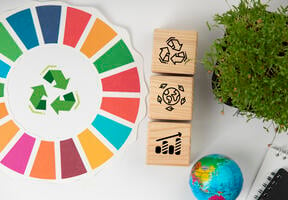Towards carbon neutrality in 2050: the IEA scenario
10 min read
Fossil fuels will not last forever, and because they emit CO2, they contribute to . In light of this, most countries across the globe have started an “energy transition”. But which path must they follow to make their transitions successful? The has published a scenario that would enable our planet to achieve ”carbon neutrality” by 2050.

© FOTOLIA - Wind turbines in Rio Vista, California: renewable energies are expanding worldwide.
“The energy transition” refers to the shift from energy production and consumption systems, which rely primarily on fossil fuels (oil, natural gas and ), to an that is more efficient and less carbon intensive.
This type of transition is nothing new. Coal in the middle of the 19th century, oil in the middle of the 20th, civilian nuclear in the 1970s, all brought about major changes in the energy mixes, although back then, the different sources did not supplant one another, but were more complementary.
No Ideal and Universal Energy Mix
Most experts agree on a number of points:
- There is no ideal mix that will be unanimously adopted worldwide. The energy transition is specific to each country or group of countries, even if the aim during international climate summits is to adopt major global objectives.
- Energy systems lack momentum, making energy transitions a slow process.
- Energy transitions cannot be achieved without disruptive technologies and without radical changes in how energy is used by consumers. The International Energy Agency has however worked on global scenarios and insisted on the need to move fast – by 2050 – if we are to limit the global average temperature rise to 1.5°C before the end of the century.
The IEA is a specialist organization, which comprises the Western developed countries and, since 2015, also includes “association members” such as China, India, Brazil, and South Africa, which gives it a worldwide audience.
For the very first time in May 2021, it published a special report which outlines a ”carbon neutral” planet by 2050, i.e. one in which CO2 emissions do not exceed the amount that can be captured1. The IEA reckons that the path is “narrow but still achievable”.
What would a carbon neutral world look like?
According to this vision of the future, which is by no means set in stone and may vary from one country to another:
- Less energy, more inhabitants? The energy demand would drop by 8% where global activity will have doubled, with an additional 2 billion inhabitants on Earth! This assumes behavioral changes, particularly in transportation, and ongoing progress in “energy efficiency”.
- The future is electric. Half of the total consumption would be ensured by , increasingly essential for urban areas, vehicles and digital tools which continue to flourish.
- Fully carbon free electricity. As early as 2040, 90% would be generated from renewable energies (including 70% from wind and solar power) and 10% from nuclear plants. One example: to reach solar objectives, it would be necessary to build facilities equivalent to the world’s current largest solar farm every day!
- Cleaner transportation means. Aircraft are essentially powered by , heavy trucks and container ships by and . 60% electric cars as from 2030.
- Technologies and yet more technologies. Known technologies need to be fine-tuned and new ones are emerging – batteries that are much larger and more efficient, processes to capture, store and recycle CO2 from industrial plants and in the air, electrolyzers to produce "green” hydrogen.
- And starting now, the IEA recommends stopping any new fossil fuel project as well as concerted action on a global scale to increase the absorption capacities of forests and soils.
But vigilance is crucial in a number of sectors:
- Always bear in mind the intermittent nature of wind and solar power so as not to disrupt the electric grids.
- Keep an eye on cybersecurity to protect systems that are increasingly smart yet vulnerable to hacking.
- Watch out for metals with limited reserves (cobalt, lithium, etc.) and for Rare Earth Elements, which will be essential for producing such quantities of electric cars, wind turbines and solar farms.






















